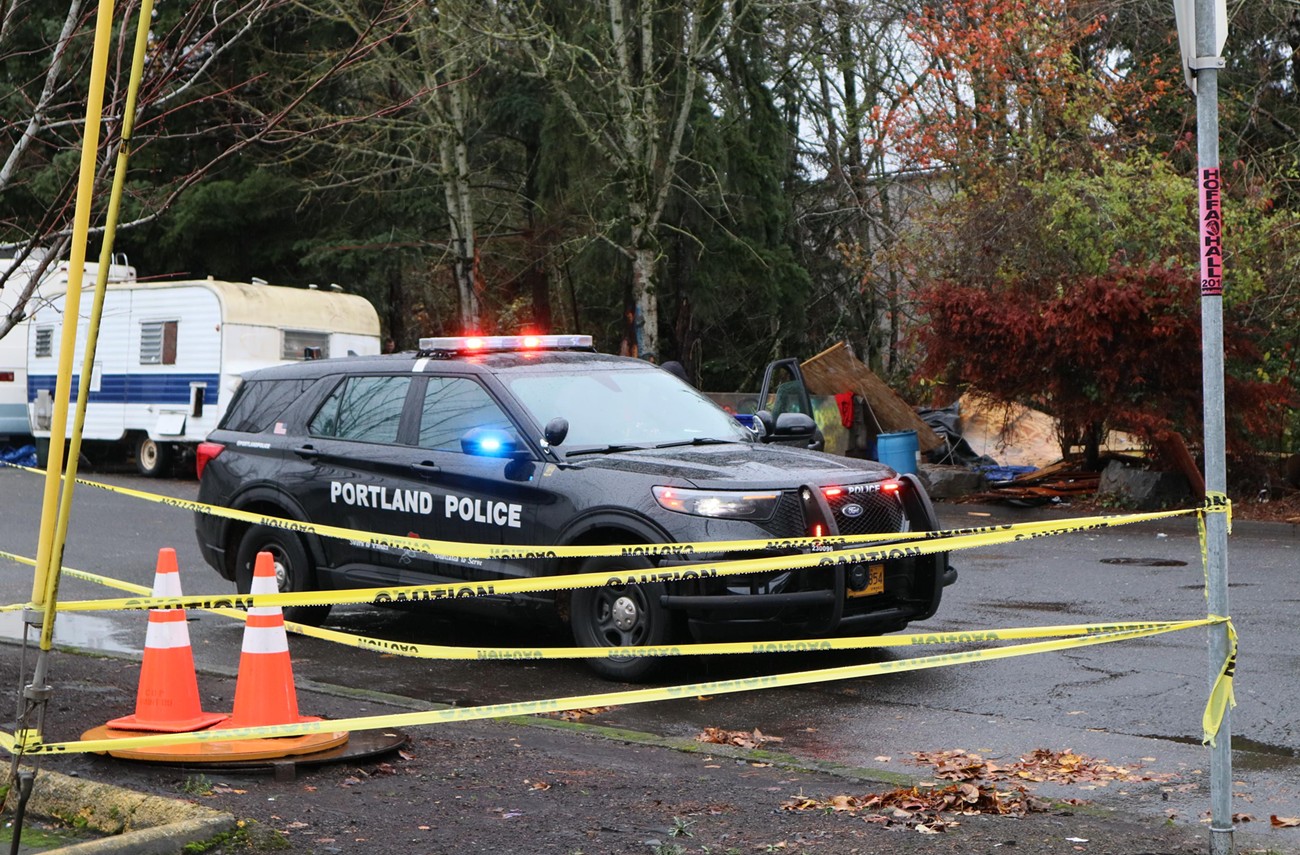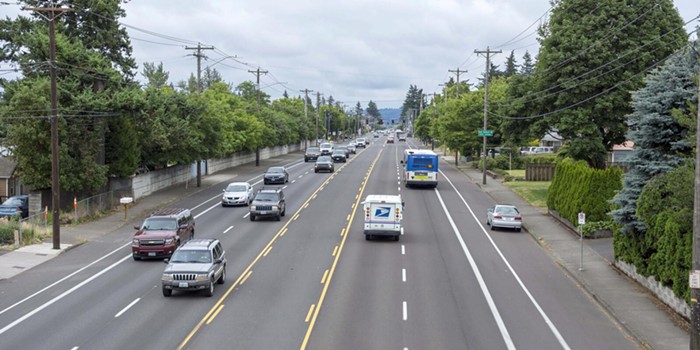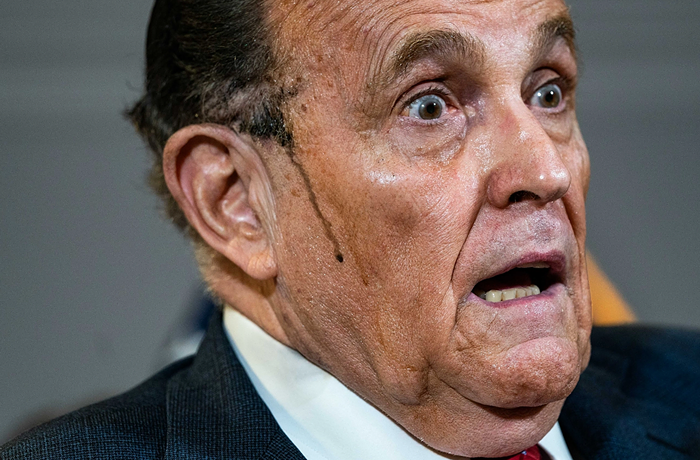As the city invests in multiple gun violence initiatives in an effort to drive down shooting and homicide rates, data shows a handful of the city’s own police officers have perpetuated gun violence on multiple occasions.
Portland Police Bureau (PPB) data shows four officers involved in recent fatal shootings have each shot at members of the public at least twice since 2021. One officer has logged three shootings in that timeframe–two of them fatal. Another officer had two non-fatal incidents. Across the bureau, police have opened fire on 21 people since 2021, 13 of whom died.
While each incident had different circumstances and police responses, the repeat shootings of residents by a handful of officers is raising alarms among police accountability advocates.
The most recent shooting by Portland police involved officer Josh Howery, who’s been with PPB for 23 years and serves on the bureau’s Special Emergency Reaction Team (SERT). Howery responded to the Portland Astoria–a downtown luxury apartment complex on Southwest Columbia Street–on Sunday, January 14, after a resident reported hearing shots fired on the eighth floor.
Police say they saw bullet strikes in the hall of the apartment building and soon after arriving, they heard “voices yelling from within an apartment, further raising concern that someone may be in danger.” A Crisis Negotiation Team was brought in, but a few hours later, a neighbor reported gunshots were piercing the walls of their apartment. That’s when Howery fired into the apartment from outside. Police say they found an AR-15 inside the home, where 31-year-old Matthew Holland was killed.
Howery was also involved in the non-fatal shooting of Antoine Young in 2022. Before that, he shot and killed Alexander Tadros in 2021. Tadros was killed after firing at police and injuring an officer.
A few weeks before the downtown apartment standoff, on December 27, police fatally shot Tyrone Lee Johnson II at the Mall 205 shopping center. Police said Johnson had a warrant for a prior robbery and was suspected of shoplifting from a Target store. He ran from them when officers moved in to arrest him. Police opened fire shortly after.
Three officers were involved in shooting Johnson–Adi Ramic, John Bartlett, and Brian Wheeler. Both Ramic and Bartlett were also involved in the non-fatal shooting of Matthew Leahey in 2022.
Before the Mall 205 shooting in December, Wheeler had been involved in another fatal shooting earlier that year. He was one of three officers who shot and killed 20-year-old Jack Watson in April 2023.
Police say they tried to pull over Watson because his car matched the vehicle description of one driven by a suspect in a murder at a Southeast Portland business the day prior. Watson fled, leading police on a pursuit into Clackamas County, where three officers, including one from Clackamas County, say Watson drew a gun and fired at them. They fired back, and Watson died at the scene.
In separate incidents, Officer Jonah Gellman fired his gun at a suspect twice from 2021 to 2022. Both events resulted in non-fatal injuries.
PPB says part of the reason for the repeat shootings by a handful of officers is their assignments.
“It’s fair to say there are some Bureau assignments where it’s more likely that officers would be in scenarios where using deadly force is likely to be used,” Sgt. Kevin Allen, a public information officer with PPB, says. “Being a member of SERT, which is a highly trained tactical team deployed on the most dangerous situations involving armed suspects, is certainly one of those assignments.”
Each officer-involved shooting undergoes an internal review and gets evaluated by the Police Review Board. The Police Review Board is a mix of PPB employees, community members and representatives from Portland’s Independent Police Review division. Any police who took part are placed on leave immediately afterward. Fatal shootings are also reviewed by PPB’s homicide unit, and typically, a grand jury will review the facts and decide whether there’s evidence of any criminal wrongdoing on behalf of the officers.
Allen said any officer or bureau employee found to have used “objectively unreasonable force” faces corrective action and possible discipline, with the stiffest penalty being termination. But officers aren’t penalized for having multiple shootings on their record.
“Simply having multiple in-policy and lawfully justified uses of deadly force would not result in discipline,” Allen says.
Even with multiple layers of review, police watchdogs and criminal justice reform advocates worry that Portland’s current system doesn’t have enough checks and balances to quell police shootings.
“It is undoubtedly true that some officer assignments are more likely to lead to uses of force than others. But saying that is the answer to why the same people are involved in multiple officer-involved shootings fails to interrogate whether there is something PPB could be doing differently to actually prevent future uses of deadly force,” says Amanda Lamb, a law enforcement resource attorney with the Oregon Justice Resource Center.
Lamb, whose organization focuses on civil rights and criminal justice reform, is representing the plaintiffs in at least one current lawsuit against the city over a fatal police shooting. She asserts the bureau, and particularly teams like SERT, should evaluate each use of deadly force to find ways it could have been prevented, then train accordingly.
“Instead, the review of officer-involved shootings focuses on whether the use of force conformed to bureau policy,” Lamb says. “In nearly every case, the use of deadly force is found to be within policy, which means the officer involved will receive no additional training or instruction on how to avoid deadly force in the future. We can’t really be surprised then that the same individual continues to be involved in similar incidents again.”
PPB says it already does just that. Sgt. Allen notes the bureau promotes continuous training, including for de-escalation and less lethal tactics, through what’s known as “annual in-service.”
“In the case of SERT, they are training constantly and placing an emphasis on using only the objectively reasonable force necessary based on the totality of the circumstances,” Allen says, noting every SERT deployment also involves the Crisis Negotiation Team, which is aimed at de-escalation. Allen says even when a shooting is deemed justified, SERT and the Crisis Negotiation Team analyze their response “to look for any lessons that may be learned or improvements that can be made.”
“Ongoing improvement and self-reflection is baked into our culture here at PPB,” Allen says.
While indictments of police are rare, civil lawsuits against them are not. The city of Portland and PPB have faced at least five wrongful death lawsuits since 2019 from the families of those killed by police.
Earlier this month, the city was named in a wrongful death suit from the family of Immanueal (Manny) Clark-Johnson.
Clark-Johnson died in November 2022 after being shot by police who mistook his vehicle for one used in an armed robbery at the Super Deluxe burger drive-thru on SE Powell Boulevard.
As PPB faces mounting calls to dramatically reduce its use of deadly force, accountability watchdogs have also led a longstanding push for more transparency around police shootings.
A policy unilaterally implemented by former Portland Police Chief Chuck Lovell now calls for a two-week waiting period before the bureau releases the names of officers involved in a deadly shooting. Lovell said the decision was in response to doxing of officers–the practice of publishing someone else’s personal information on the web, typically with the intent to target or harass them. PPB cited a concern for officer safety as the catalyst for withholding names.
The decision and its lack of public vetting has been a sticking point for groups like Portland Copwatch and other accountability advocates. Critics note PPB never got explicit approval for the change in policy from the US Department of Justice, which PPB has an active settlement agreement with. That agreement stipulates that any use of force policies need to be reviewed and approved by the DOJ.
Instead, PPB points to correspondence from a Portland-based FBI agent who suggested the bureau “review their policies regarding the release of officers' personal information immediately following critical incidents.”
The memo suggests “withholding of this information will balance the officer's safety, the integrity of ongoing investigations, and the public's need to be informed of any facts surrounding the incidents.”
Jake Dockter is among those who say the move further erodes public trust in the police bureau.
“Police brutality, especially lethal force by police and PPB specifically, is an area where the community has demanded change for a long time,” Dockter says. “This is where police abuse most reveals itself. While PPB continuously tells us in public that they are committed to transparency and change we continue to examples of them either unable to get the facts right or misrepresenting the truth.”
PPB points to its officer-involved shooting dashboard, which lists details, including incident summaries and investigative case files, as evidence of its commitment to transparency.
Allen says the incident dashboard is especially important for uses of deadly force “given the significant impact on the family and loved ones of those involved, the wider community, and the membership of the Police Bureau.”
Even fierce critics of PPB agree the dashboard is a necessary, helpful tool. But they’d rather the police not have to update it every few months.
Lamb, who has worked with survivors and loved ones of those shot by police, questions whether the bureau is stymied by its own policies and mechanisms.
“In my experience, the victims, their families, and the public care more about the tragedy of the injuries or the life lost and how to prevent similar incidents of violence,” she says. “Whether policy was followed is not the primary question. The primary question should be what is PPB doing to prevent future uses of deadly force.”




















